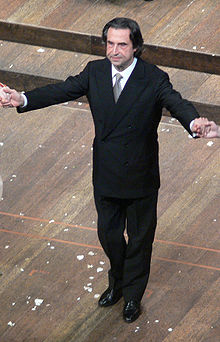I have been visiting a friend in the Chicago area and have had the opportunity to
hear two orchestral concerts with choir, one featuring a regional symphony orchestra and one by of the world's finest ensembles.

 The first was on Friday evening, April 10, when the Mahler Second
Symphony was performed by the Northwest Indiana Symphony Orchestra, conducted
by Kirk Muspratt. The concert was held at Bethel
Church in Crown Point, Indiana.
The soloists were Alison Wahl, soprano,
The first was on Friday evening, April 10, when the Mahler Second
Symphony was performed by the Northwest Indiana Symphony Orchestra, conducted
by Kirk Muspratt. The concert was held at Bethel
Church in Crown Point, Indiana.
The soloists were Alison Wahl, soprano,
 and Margaret Stolz, mezzo-soprano. The
chorus was prepared by Nancy Menk.
and Margaret Stolz, mezzo-soprano. The
chorus was prepared by Nancy Menk.
Since my friend sings in the Symphony Chorus, I was able to
attend both the dress rehearsal and the performance. The church auditorium is
not set up as a traditional church with an apse, a nave, and a crossing, or as a concert hall, but has an enormous, wide stage stretched across the
front of the room, making it necessary to spread out the forces in order to fit everyone on stage.
On either side of the main area, platforms were built that projected out from the stage on which were placed the
percussion at stage right and the bass fiddles at stage left. This gave undue
prominence to these sections of the orchestra visually and acoustially. The chorus was stretched across
the entire width of the back of the stage behind the orchestra, making it difficult for the
different sections to hear each other. The chorus was also amplified for some reason, as were the soloists. Somehow, they held it together and sang
well.
For a dress rehearsal there was a lot of starting and stopping. In my experience, a dress rehearsal is just that: you pretty much go through the program making small, final adjustments. Apparently not that much rehearsal time is affordable for the orchestra budget so a lot of last minute 'fixing' is needed.The room is incredibly live and the overall effect was of too much sound. Especially in the case of the sopranos and first violins it was shrill and hard on the ears. By the performance this balance was tempered a bit by having a full house, making it less painful but acceptable.
Mr. Muspratt tends to spend a great deal more time dealing
with the orchestra than he does cueing the chorus. Nevertheless, they managed just fine without a lot
of help from him.
The two solo singers have lovely voices but are a bit lacking in
the kind of vocal power to be heard over such a large orchestra and chorus. They both resorted to numerous breaths within a phrase, breaking up the long
lines of the music. Having heard Lorraine
sing the mezzo role many times, it takes her kind of vocal and emotional
projection to make oneself be heard amid all the other sound that is going on. I would love to hear Eileen Farrell in the
soprano role, but, unfortunately, neither of these fine singers is still with
us.
The work, like many of Mahler’s orchestral pieces is overly
long. The intermission came between the second and third movements. It makes
for a long sit. Mahler does much better when setting songs, where the limitations of the text force him to cut back on the length of the work.
Mr. Muspratt had brass players in the rear of the auditorium
and backstage at various times, which worked very effectively. The piece ranges
from bucolic moments with Landler type movement, to enormous climaxes of
ear-splitting force, especially in this overly bright room. This problem resolved itself better with a full house than it had been at the dress rehearsal with only a
few people in the seats. Still, because of the positioning of the percussion in
the front row, as it were, when they took off in a big moment, I was tempted to
put my fingers in my ears. The cymbal player had a lot of work to do and inadvertently became one of the soloists.
In the rehearsal, the sound of both the violins and the sopranos
was very shrill when playing and singing in the upper register. This, too, was
modified in the performance with more people in the hall. I would like to hear the work done by the same
forces in a better acoustical situation.

Overall this is a great work and was done well considering the space in which it was performed.
++++++++++++++++++++++++++
What a difference a couple of days makes. Tonight (April 16th) David
and I heard the Chicago Symphony perform Bach’s Mass in B Minor. The comparison
with last Friday’s Mahler 2nd with the Northern
Indiana symphony was interesting and revealing. While the Indiana Symphony plays
well, the Chicago Symphony is extraordinary. I guess that that is to be expected when comparing a regional orchestra with one of national stature, but the
juxtaposition of these two orchestras within a space of several days surely
separates the sheep from the goats.
 As to the conductors, while Mr. Muspratt is an able director
Ricardo Muti is a genius. He conducted this massive work with a minimum of motion
and a maximum of emotion, expressed in small, often invisible gestures. At
times, when a small orchestral group was accompanying a soloist. He merely
stood quietly, barely moving his body, and just allowed the musicians to play. It
was fabulous. Mr. Muspratt tends to use Leonard Bernstein-like gestures, which may look dramatic but don't always do much for the music.
As to the conductors, while Mr. Muspratt is an able director
Ricardo Muti is a genius. He conducted this massive work with a minimum of motion
and a maximum of emotion, expressed in small, often invisible gestures. At
times, when a small orchestral group was accompanying a soloist. He merely
stood quietly, barely moving his body, and just allowed the musicians to play. It
was fabulous. Mr. Muspratt tends to use Leonard Bernstein-like gestures, which may look dramatic but don't always do much for the music.
The Symphony chorus sang wonderfully well; brilliantly when
needed and poignantly in moments like the 'Et incarnatus est'. I would have liked more sound from the sopranos and altos, but it may be the fact that I was seated on the opposite side of the hall from them. But to my ears, some more female voices would have balanced the robust sound of the men. The altos, as is often the case, were often not heard. I guess that goes with being an alto. Otherwise, the acoustics of the hall seemed fine.


The soloists were Eleonora Buratto, soprano, Anna Malavasi,
mezzo-soprano, Saimir Pirgu, tenor, and Adam Plachatka, bass-baritone.
The men sang far better that the women. Both
of the
women sang with an upholstered sound that seemed totally manufactured. They
both took excessive liberties with their breathing that were really annoying. For
instance, in the 'Agnus Dei', Ms. Malavasi took four breaths in the opening
phrase. These were not the voices I would choose for this work. Actually the two women singers from the Mahler have much more beautiful
and natural sounding voices. I would like to hear them in this situation.


Mr. Plachatka just doesn't have the low notes for the first
bass aria, 'Quoniam tu solus sanctus'. There
is a breathy sound
in that part of his voice which comes from trying to
push the sound down rather than letting it find
chest resonance freely. He was much better in 'Et in spiritum sanctum Dominum'
which lies in a higher range.

Mr. Pirgu is an extraordinary tenor with a beautiful sound,
a free technique and a ver
y musical approach to his arias. His use of
voix mixe in the 'Benedictus' was
amazing.
This is simply one of the very greatest works in the musical
repertoire and it was performed at the highest possible level. My hat is off to Mr. Muti. He is a great conductor.
I was thrilled to be there for this marvelous performance.
 Phyllis and I also talked about the current rage to bring little known middle European singers to this country ignoring our own very excellent American variety. Phyllis will be teaching again at Tanglewood this summer for the 50th season. She said she has had hundreds of fine young singers go through her class only to have a tough time getting hired.
Phyllis and I also talked about the current rage to bring little known middle European singers to this country ignoring our own very excellent American variety. Phyllis will be teaching again at Tanglewood this summer for the 50th season. She said she has had hundreds of fine young singers go through her class only to have a tough time getting hired.




